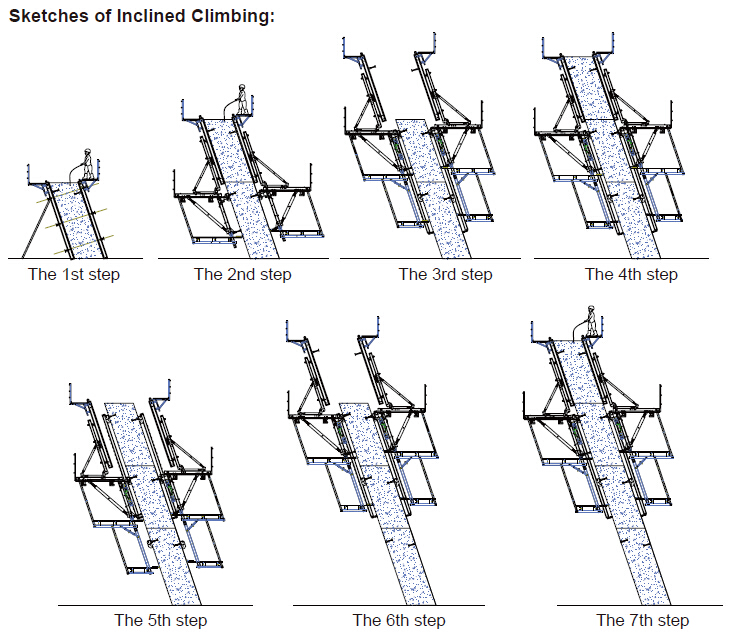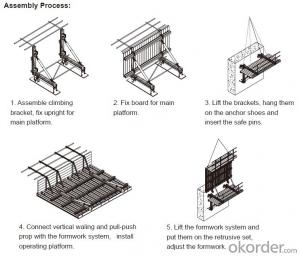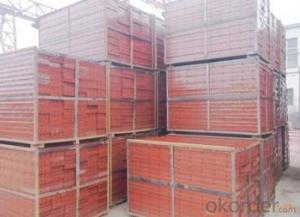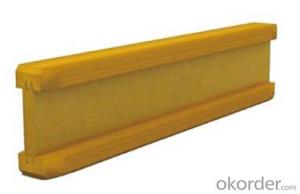Auto Climbing Bracket ACB100 & ACB50 for formwork and scaffolding system
- Loading Port:
- Tianjin
- Payment Terms:
- TT OR LC
- Min Order Qty:
- 50 m²
- Supply Capability:
- 1000 m²/month
OKorder Service Pledge
OKorder Financial Service
You Might Also Like
Auto-climbing Bracket ACB100 & ACB50
The power of the auto-climbing formwork is the hydraulic system, which includes the oil cylinder
and two commutators. The commutators can control the climbing of climbing rail and the bracket.
The steel rail and the bracket can inter-climbing, so the whole system will climb up steadily.
Cranes are not needed during the construction. It’s easy to operate, highly efficient and safe. It’s
the best choice for the construction of high buildings and bridges.
There are mainly two types of standard auto-climbing brackets, ACB-50 and ACB-100, the figure
means the push power of cylinder with unit of KN.
Characteristics:
◆ Perfect load bearing anchor system
Anchor system is the most important supporting part. The system is made of five parts shown
below. Thereinto, tensile bolt, V-climbing cone and washer can be taken out for reusing after the
concrete pouring finished.There are two kinds of anchor systems,A & B. A is matched with single
anchor shoe and B is matched with double anchor shoe.
◆ Crane-independent
Crane-independent forming, striking and climbing speeds up the work procedures on the
construction site and also makes them independent of each other. This means the planned
sequences can be maintained along with guaranteeing high productivity levels. The crane can
therefore be used for other tasks.
Hydraulic system is mainly made of two commutators,
oil cylinder and power distribution system.The
commutators can control the climbing of climbing rail
and bracket.
◆ High bearing capacity and safe
The stable working platforms are able to carry large loads, e.g. the storage of reinforcing steel
for the next climbing section. Generously-sized working platforms, the well thought-out design for
handling very high wind loads and the patented control function of the climbing mechanism are
some of the special details contained within the comprehensive safety concept.
◆ Platforms adjusted to suit the angle of inclination
The horizontal working areas thus created provide safe and comfortable conditions for
reinforcement work, shuttering and striking, concreting and finishing.
◆ The ACB formwork system can climb not only vertically but also slantways, the largest angle is
18 degrees.
◆ The system can climb up wholly or separately. The climbing process is steady, synchronous
and safe.
◆ The bracket will not fall to the ground until the construction is finished, the field will be saved
and the impacting breakage will be reduced (especially the panel).
◆ The system will furnish omnidirectional platform, the construction organizations don’t need to
set up additional operation platform.
◆ The error of structure construction is small and easy to correct.
◆ The climbing speed is fast, the construction course will be quickened.
◆ The formwork can climb itself and cleaning work can be done in the same situs , the used times
of tower crane will be greatly reduced.

- Q: How does steel formwork handle different concrete pouring techniques?
- Steel formwork is a versatile and durable option for handling different concrete pouring techniques. Its strength and rigidity allow it to withstand the pressure exerted by various pouring methods, ensuring a stable and secure structure. One common pouring technique is the traditional gravity pouring, where concrete is poured into the formwork from the top and allowed to flow downwards due to its own weight. Steel formwork is well-suited for this method as it can easily contain the concrete and prevent any leakage or spillage. The formwork's tight joints and sturdy panels ensure that the concrete remains in place and is evenly distributed throughout the formwork. Another technique is the pumping method, where concrete is pumped into the formwork using specialized equipment. Steel formwork can handle this technique effectively as it can withstand the force and pressure exerted by the pumping process. The formwork's robust construction and reinforced edges provide the necessary support to contain the concrete and prevent any deformation or leakage. Steel formwork is also compatible with the slip-forming technique, which involves continuously pouring concrete into a moving formwork system. This method requires a formwork system that can be easily moved and adapted to changing shapes and heights. Steel formwork's modular design allows for quick and efficient adjustments, making it suitable for slip-forming applications. Additionally, its strength and stability ensure that the formwork remains intact during the continuous pouring process. In summary, steel formwork is a reliable choice for handling different concrete pouring techniques. Its strength, rigidity, and adaptability make it capable of withstanding the pressure and forces exerted by gravity pouring, pumping, and slip-forming methods. With steel formwork, builders and contractors can confidently execute various concrete pouring techniques, resulting in high-quality and structurally sound construction projects.
- Q: What are the common design considerations for steel formwork in marine environments?
- Some common design considerations for steel formwork in marine environments include corrosion resistance, durability, strength, and stability. Steel formwork used in marine environments should be made from corrosion-resistant materials, such as stainless steel or galvanized steel, to prevent degradation due to exposure to saltwater. It should also be designed to withstand harsh weather conditions, including high winds and waves, to ensure its longevity. Additionally, the formwork should have sufficient strength and stability to support the weight of concrete and withstand the forces exerted by the marine environment. Proper sealing and maintenance of the formwork are also vital to prevent water infiltration and maintain its effectiveness.
- Q: Can steel formwork be used in sports facility construction projects?
- Yes, steel formwork can be used in sports facility construction projects. Steel formwork is a versatile and durable option that offers several advantages. Firstly, it provides a high level of strength and stability, making it suitable for large-scale structures like sports facilities. Steel formwork can withstand heavy loads and pressures, ensuring the integrity and safety of the construction. Additionally, steel formwork is highly reusable, which can significantly reduce construction costs and waste. It can be easily dismantled, cleaned, and reassembled for future projects, making it a sustainable choice for sports facility construction. Moreover, steel formwork allows for precise and accurate construction. Its rigidity and dimensional stability ensure that the desired shape and dimensions of the sports facility are achieved. This is particularly important in sports facilities where precise measurements and uniformity are crucial for proper functionality. Furthermore, steel formwork provides a smooth and uniform surface finish. This is essential in sports facilities where the playing surface needs to be even and consistent to ensure fair gameplay and prevent injuries. In summary, steel formwork is a suitable option for sports facility construction projects due to its strength, reusability, precision, and smooth surface finish. It offers numerous benefits and can contribute to the successful completion of sports facilities.
- Q: What are the different material handling requirements for steel formwork?
- The different material handling requirements for steel formwork involve proper storage, lifting, transportation, and maintenance of the steel components. Steel formwork should be stored in a dry and secure area, away from moisture and exposure to the elements. When lifting, it is essential to use appropriate lifting equipment and follow proper rigging procedures to ensure the safety of workers and prevent damage to the formwork. During transportation, the steel formwork should be securely fastened and protected from any potential impacts or vibrations. Regular maintenance, including cleaning, inspection, and repair, is crucial to ensure the longevity and performance of the steel formwork.
- Q: Can steel formwork be used for precast concrete slabs?
- Yes, steel formwork can be used for precast concrete slabs. Steel formwork provides a durable and strong solution for casting precast concrete slabs, ensuring accurate dimensions and a smooth finish.
- Q: How is steel formwork different from other types of formwork?
- Steel formwork differs from other types of formwork primarily because it is constructed from steel, which provides several distinct advantages. Firstly, steel formwork exhibits exceptional durability and can endure heavy loads and repeated use without warping or damage. This makes it well-suited for utilization in extensive construction ventures where formwork must be employed multiple times. Furthermore, steel formwork is renowned for its remarkable strength and stability. It can support concrete walls and slabs without necessitating supplementary support structures, reducing construction time and expenses. Its inflexibility also guarantees that the formwork retains its shape and prevents concrete from leaking or shifting during pouring and curing. Another notable benefit of steel formwork is its adaptability and versatility. It can be easily tailored to meet diverse project requirements, enabling the construction of intricate shapes and designs. This flexibility renders steel formwork suitable for a wide array of applications, including tall buildings, bridges, tunnels, and even curved structures. Moreover, steel formwork provides excellent surface finish quality. Its smooth and uniform surface diminishes the need for additional finishing work, conserving time and resources. It also imparts a uniform appearance to the completed concrete structure. In terms of cost-effectiveness, steel formwork may entail a higher initial investment compared to other formwork types, such as wood or aluminum. However, its durability and reusability compensate for the higher upfront expenses in the long run. Additionally, the efficiency and rapidity of construction achieved with steel formwork can result in substantial time and labor savings, making it a cost-effective choice for large-scale projects. Overall, steel formwork distinguishes itself through its durability, strength, adaptability, surface finish quality, and cost-effectiveness. These characteristics render it a popular selection in the construction industry for projects that require a sturdy and dependable formwork system.
- Q: Can steel formwork be used for both monolithic and composite structures?
- Yes, steel formwork can be used for both monolithic and composite structures. Steel formwork provides the necessary strength and durability required for these types of structures, making it a versatile option for construction projects.
- Q: Can steel formwork be used for both single-storey and multi-storey structures?
- Yes, steel formwork can be used for both single-storey and multi-storey structures. The versatility and strength of steel make it suitable for various construction projects, regardless of the number of storeys in the building. Steel formwork offers durability, easy assembly, and reusability, making it a popular choice for both small and large-scale construction projects.
- Q: How does steel formwork affect the overall dimensional stability of a structure?
- The overall dimensional stability of a structure can be significantly improved by using steel formwork. Steel formwork is known for its strength and rigidity, which makes it an excellent support system during construction. This ensures that the concrete is accurately and precisely placed, resulting in a structure with enhanced dimensional stability. There are several advantages to using steel formwork that contribute to its overall dimensional stability. Firstly, steel has a high strength-to-weight ratio, allowing for the creation of strong and durable formwork systems. This strength prevents any shifts or movements in the formwork during concrete pouring, reducing the likelihood of dimensional changes in the final structure. Furthermore, steel formwork offers superior dimensional accuracy compared to other materials. The steel plates or panels used in the formwork can be manufactured with high precision, resulting in consistent dimensions and smooth surfaces. This eliminates any inconsistencies or irregularities that may occur with traditional formwork materials like wood or plywood, further enhancing the overall dimensional stability. In addition, steel formwork is highly resistant to moisture, humidity, and temperature variations, which can cause dimensional changes in other materials. This resistance ensures that the formwork remains stable and maintains its original shape, even in challenging environmental conditions. The stability extends to the concrete poured within the formwork, as the steel helps to minimize shrinkage and expansion, reducing the risk of cracks or warping in the structure. In conclusion, steel formwork is essential for maintaining the overall dimensional stability of a structure. Its strength, precision, and resistance to environmental factors ensure that the formwork remains intact and accurately supports the concrete placement. By providing a reliable and robust framework, steel formwork allows for the creation of structures with enhanced dimensional stability, resulting in a long-lasting and durable final product.
- Q: How does steel formwork affect the overall construction site waste recycling?
- The overall waste recycling at a construction site can be greatly influenced by steel formwork. In contrast to traditional timber formwork, steel formwork is more long-lasting and can be reused multiple times. This results in a decrease in waste production at the construction site since there is less necessity for the production and disposal of new formwork materials. Furthermore, cleaning and maintaining steel formwork is simpler, which extends its lifespan and reduces the need for replacement. This not only decreases waste but also saves costs associated with purchasing new formwork materials for each construction project. Moreover, steel formwork is highly recyclable. Once its life cycle is complete, it can be recycled and utilized to manufacture new steel products, diminishing the demand for fresh materials and reducing the environmental impact. Through the utilization of steel formwork, construction sites can greatly diminish their waste generation and contribute to a more sustainable construction industry. This not only benefits the environment but also promotes a more efficient and cost-effective approach to construction.
Send your message to us
Auto Climbing Bracket ACB100 & ACB50 for formwork and scaffolding system
- Loading Port:
- Tianjin
- Payment Terms:
- TT OR LC
- Min Order Qty:
- 50 m²
- Supply Capability:
- 1000 m²/month
OKorder Service Pledge
OKorder Financial Service
Similar products
Hot products
Hot Searches


















